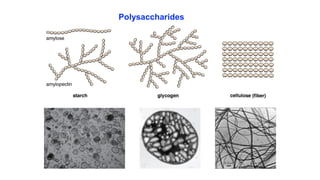The document discusses biomolecules and carbohydrates. It notes that cells are composed of water, inorganic ions, and carbon-containing organic molecules. Macromolecules like carbohydrates, lipids, proteins, and nucleic acids account for 80-90% of a cell's dry weight. Carbohydrates can be monosaccharides, oligosaccharides, or polysaccharides depending on their structure. Monosaccharides include glucose and provide energy, while polysaccharides like starch and glycogen store sugars. Dietary carbohydrates should make up 45-65% of caloric intake and provide 4 calories per gram as an easily accessible energy source, though fiber is important for regulating blood sugar and digestion.
























